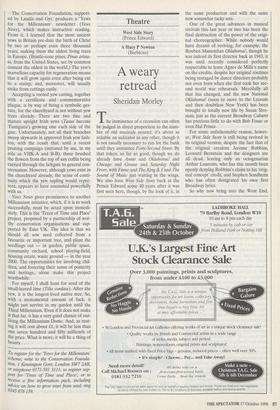Gardens
You and yews
Ursula Buchan
The village has been slow to catch Mil- lennium Fever. Although invited, even exhorted, by both parish council and parochial church council to 'come up' with ideas on how to mark it, and despite the inherent fascination of the prospect, sug- gestions are 'coming up' in a trickle rather than a flood. We seem intimidated by the momentous nature of the duty with which we have been entrusted. I imagine the splendour, magnificence and congruity of the Millennium Dome makes any scaled- down initiative that we might devise look, frankly, pretty dim.
My commitment to the Millennium cele- brations so far has been two-fold. I have diffidently (because I am not very skilled) volunteered to ring one of the bells in the church tower at noon on 1 January 2000, when bells are to be rung in every church in the country. I appreciate that some might argue that this is not really in the true spirit of the Millennium celebrations: the almost compulsory Millennial hangover will be a distinct disadvantage; the event will not be happening in a far-off holiday destination; and the children who take part will learn less about life than they would by climbing inside a giant androgyne in Greenwich. Nevertheless, we seem set on doing it.
Second, in my capacity as village horti- cultural know-all and bossy-boots, I have registered with the Conservation Founda- tion, in order to receive a young yew plant to put in the churchyard in the year 2000. This will have been propagated vegetatively from (and, therefore, be genetically identi- cal to) one of the extraordinarily ancient trees which are scattered about the coun- try, mostly in churchyards. The Conservation Foundation, support- ed by Landis and Gyr, produces a 'Yews for the Millennium' newsletter (Yews News), which makes instructive reading. From it, I learned that the most ancient yews in Britain pre-date the birth of Christ by two or perhaps even three thousand years, making them the oldest living trees in Europe. (Bristle-cone pines, Pinus arista- ta, from the United States, are by common consent the oldest in the world.) The yew's marvellous capacity for regeneration means that it will grow again even after being cut to a stump, and, moreover, will usually strike from cuttings easily.
Accepting a rooted yew cutting, together with a certificate and commemorative plaque, is by way of being a symbolic ges- ture, for the churchyard is not without yew trees already. There are two fine and mature upright Irish yews (Taxus baccata Tastigiata) growing one each side of the gate. Unfortunately, not all their branches sweep skywards in approved Irish yew fash- ion, with the result that, until a recent pruning campaign (initiated by me, in my role as VHK-A and B-B), these brushed the flowers from the top of any coffin being carried through the lichgate to general con- sternation. However, although yews exist in the churchyard already, the sense of conti- nuity which the yew sapling would repre- sent, appears to have resonated powerfully with us.
Yews News gives prominence to another Millennium initiative, which, if it is to work successfully, must be acted upon immedi- ately. This is the 'Trees of Time and Place' project, proposed by a partnership of wor- thy conservation organisations and sup- ported by Esso UK. The idea is that we should all sow seed collected from a favourite or important tree, and plant the seedlings out — in garden, public space, community orchard, school playing-field, housing estate, waste ground — in the year 2000. The opportunities for involving chil- dren, and fostering their sense of posterity and heritage, alone make this project worthwhile.
For myself, I shall hunt for seed of the small-leaved lime (Tilia cordata). After the yew, it is the longest-lived native tree. So, with a monumental amount of luck, it might just survive in my garden until the Third Millennium. Even if it does not make it that far, it has a very good chance of out- living the Millennium Dome. And, as rear- Mg it will cost about £1, it will be less than one seven hundred and fifty millionth of the price. What is more, it will be a thing of beauty .
To register for the 'Yews for the Millennium' scheme, write to the Conservation Founda- tion, 1 Kensington Gore, London SW7 2AR, or telephone 0171-591 3111; to register sup- port for 'Trees of Time and Place, or to receive a free information pack, including advice on how to grow trees from seed, ring 0345 078 139.











































































 Previous page
Previous page